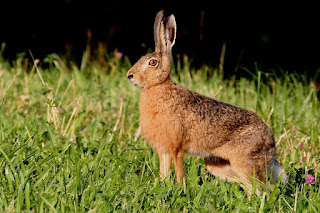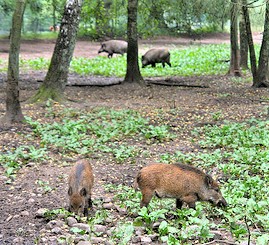from
Behind the French Menu
by
Bryan G. Newman
behindthefrenchmenu@gmail.com
Farmed
European Rabbit
Rabbit
Rabbit and hare have always been popular
in French cuisine and will be on many French restaurant menus. Rabbit is tasty,
inexpensive, and an easy to cook food, and until some sixty-plus years ago,
rabbit was also a British and North American staple. During WWII, British
families raised rabbits for food in their back gardens.
The rabbit on your French menu will have
been farm-bred for the cooking pot. There are many types of rabbits in Europe,
but those that are raised for food will have developed from the wild European
rabbit. Rabbits are classified with chicken for their ease of preparation in
the kitchen and will be on many bistro menus as a comfort food.
Stuffed rabbit
saddle with spinach,
Sauteed
artichokes, carrots, and ragout of rabbit kidney.
(The
saddle is the meatiest part of a rabbit or hare).
Farmed rabbit, will be on the menu all year round, and over the Easter weekend rabbit is a traditional French family dish. Wild rabbit, Lapin de Garenne, will be on some menus during the hunting season.
Rabbit on French menus:
Lapin à la Kriek – Rabbit cooked in a Belgian, cherry-flavored, beer. Kriek is the Flemish name for a popular sour red cherry.
Saddle of rabbit at Per Se, New York.
www.flickr.com/photos/mascardo1/2602389527/
Lapin En Hure – Rabbit cooked with herbs and vegetables and served de-boned in aspic. The way this dish is served depends on the chef. Small portions may be offered as an entrée; a larger serving may come with a sauce ravigote as the main course. Sauce Ravigote is a thick vinaigrette sauce made with mustard, eggs, olive oil, and herbs.
Lapin en Paquets - Rabbit in packets, a popular Provençal dish where the rabbit is cooked in small pieces wrapped in bacon, flavored with garlic and served with tomatoes and sweet peppers.
Braised rabbit with gnocchi
www.flickr.com/photos/tomspix/5988021334/
Râble de Lapin Farci de Figues – Roast saddle of rabbit stuffed with figs. The saddle is the center of the back and the meatiest part of a rabbit or hare.
Salade de Foies de Lapin’s Grillés, Vinaigrette à la Framboise – A salad of grilled rabbit liver served with a raspberry vinaigrette.
Rabbit does not taste like chicken; it has a stronger taste with very tender meat. Rabbit has more protein than chicken, beef, veal a or pork, and less cholesterol than chicken, turkey, beef or pork
Lapin Charentais des Mille Vents, Label Rouge – This is one of the six highest quality,
farm-raised rabbits in France. This rabbit and five others hold the Label
Rouge, the red label, for consistent quality and a high standard of animal
husbandry. This farm-raised rabbit comes from the part of Poitou-Charentes now
included in the super-region of Nouvelle Aquitaine.
Rabbits have been farm-raised for food
since the 15th century and only came to be considered as a pet in the 19th
century and those are different breeds.
,
According to Dictionary. Com, the word
rabbit, came to English from old-French. That indicates that it came to England
from 1066 and onwards. From 1066 with the invasion of William the Conqueror,
most of the British court spoke French, and for 400 years, most British queens
were French imports. Many of the words used in the English kitchen today came
from Norman French. For more about the French influence in the English
kitchen, click here.
Rabbit in the languages of
France's neighbors:
(Catalan - conill de bosc),
(Dutch - konijn ).(German - wildkaninchen), (Italian
- coniglio), (Spanish - conejo),
Lièvre – Hare.
Lièvre – An adult hare.
France farm raises most of their hares,
and they will be on menus all year round. Hare has a slightly different taste
to rabbit and a different texture.
Levraut - A young hare.
In English, a young hare is a leveret.
Hare on French menus:
Civet de Lièvre, Trompettes de la Mort et Céleri Rave – A traditional stew prepared with
the black horn of plenty mushrooms and celeriac. The French usually prepare celeriac, with
its light taste of celery as a slightly rough puree that, in a restaurant’s low
lighting, you may mistake for hand mashed potatoes.
Lièvre à la Royale – Hare in
the Royal manner, the most famous of all French recipes for hare; it is a dish
that often has to be ordered days in advance. Here the hare is marinated for
two or three days with thyme, cognac, and red wine and then cooked with pork, foie gras, red wine, onions, garlic, shallots, and truffles if available. Traditionally this dish was
made with wild hare, but this dish is available all year round, and wild hare
are only caught in a limited hunting season.
Sometimes this dish is mistranslated on a French menu into English
as Jugged Hare. Jugged hare is a traditional English dish and they are not the
same? Jugged hare is wild hare marinated for a few days in red wine, garlic,
and herbs and then served fried with salt
pork prepared in its wine marinade. Alas, jugged hare misses the cognac,
foie gras, shallots,
and truffles that are part of lièvre à la royale. They are clearly not the
same.
Filet de Lièvre, Salsifis. Amandes Fumées, Purée de Pommes de Terre aux
Betteraves – A cut
from a hare’s saddle served with salsify, the oyster plant, smoked almonds, and pureed
potatoes flavored with beetroot.
Lièvre de Chasse – Wild
hare; hare caught in the wild. It is not easy to catch a wild hare, they can
run at up to 50 km an hour (31 miles an hour), and that makes them stringy and
tough. Wild hare requires a great deal of preparation.
.
While enjoying an excellent dish of
farm-raised hare, I listened to a discussion with knowledgeable lovers of the
great outdoors. Despite the meal that they were so obviously enjoying, they
insisted that hares are impossible to farm raise. They said that hares are too
flighty and will die after one day in captivity or else will not breed; they
insisted that the hare on our menu was wild. When you hear these arguments put
them in touch with the French Fédération
des Éleveurs de Lièvres, the French Hare Breeders Federation. They will let
them visit one of their member’s farms, which are open to the public.
Hare in the languages of France’s
neighbors:
(Catalan - llebre), (Dutch - haas),
(German - echten hasen ), (Italian - lepre, lepre comune), (Spanish - liebre).
--------------------------------
Behind the French Menu
by
Bryan G. Newman
behindthefrenchmenu@gmail.com
Copyright 2010, 2014, 2018, 2019
--------------------------------
Searching for the meaning of words, names or phrases
on
French menus?
Just add
the word, words, or phrase that you are searching for to the words "Behind
the French Menu" (best when including the inverted commas), and search with
Google, Bing, or another browser. Behind the French Menu’s links,
include hundreds of words, names, and phrases that are seen on French menus.
There are over 450 articles that include over 4,000 French dishes with English
translations and explanations.
Connected Posts:











